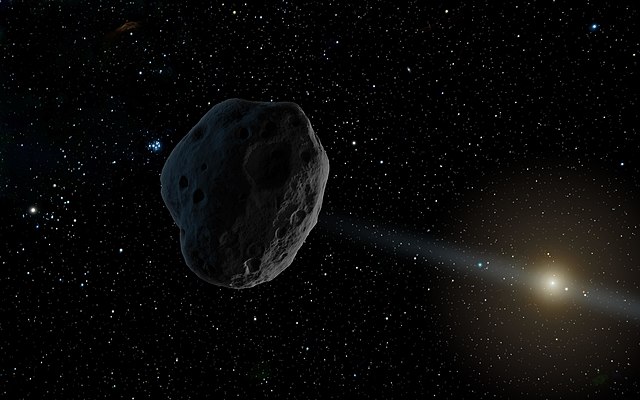 Asteroid Could Collide With Earth on Valentine’s Day in 2046. Credit: Flan la / Wikimedia Commons / CC BY-SA 4.0
Asteroid Could Collide With Earth on Valentine’s Day in 2046. Credit: Flan la / Wikimedia Commons / CC BY-SA 4.0Astronomers have discovered a new asteroid, designated 2023 DW, and it presents a possible threat of collision with Earth. It was just two weeks ago, on February 26th, that it was discovered by the European Space Agency.
Since then, the asteroid has been added to the Risk List, which is a catalog maintained by the agency to record space objects that might possibly have some type of influence on Earth. At this time, it has been assigned a score of 1 on the Torino Scale, which indicates that it is currently anticipated to present “no unusual level of danger.”
Size of 2023 DW uncertain
According to the experts’ findings, the diameter of 2023 DW is around 50 meters, approximately the length of an Olympic-sized swimming pool. Yet, they say, ” size uncertainty could be large.” As a consequence of this, the possibility of a collision is now considered to be very small, and the asteroid’s ranking on the Risk List is currently at No. 1, while the scale rating of each of the other 1,448 asteroids on the Risk List is 0.
Probability of Asteroid Colliding With Earth
According to the most recent calculations by the European Space Agency (ESA), the asteroid only has a one in 607 probability of colliding with Earth, with the earliest possible impact being still more than two decades away. In the unlikely event of a collision, the asteroid would be anticipated to smash the globe on Valentine’s Day 2046.
It also has the potential to have an influence on Valentine’s Day in the years to come, namely from 2047 through 2051.
The Planetary Defense Coordination Office at NASA has been monitoring the asteroid and has determined that there is still only an extremely tiny chance that it could collide with Earth in 2046.
The office said in a tweet that when new objects are found for the first time, it often takes several weeks of data to correctly estimate their orbits years into the future. This is because there are many uncertainties involved.
We've been tracking a new asteroid named 2023 DW that has a very small chance of impacting Earth in 2046. Often when new objects are first discovered, it takes several weeks of data to reduce the uncertainties and adequately predict their orbits years into the future. (1/2) pic.twitter.com/SaLC0AUSdP
— NASA Asteroid Watch (@AsteroidWatch) March 7, 2023
Piero Sicoli, an astronomer, thinks that there is a “1 in 400 probability” that there will be an impact, confirming that the likelihood of an impact occurring is very low.
“Surely this possibility will soon be ruled out,” he said in a Tweet. “However, as an exercise, I calculated where the asteroid might fall if this possibility occurred.”
#2023DW. With just 3 days of arc, I found about 1 in 400 chance of impact on Feb. 14, 2046 (JPL 1/770). Surely this possibility will soon be ruled out, however, as an exercise, I calculated where the asteroid might fall if this possibility occurred. pic.twitter.com/ldlSYJMvMz
— PS (@Piero_Sicoli) March 2, 2023
His estimates suggest that the asteroid could hit the Earth anywhere between the Indian Ocean, off the southern tip of India, and a point close to the East Coast of the United States. However, it is essential to keep in mind that the results of these computations can change in the future.

 1 year ago
72
1 year ago
72











 English (US)
English (US)